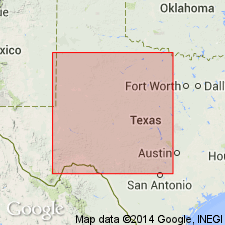
- Usage in publication:
-
- Eastland Lake formation
- Modifications:
-
- Original reference
- Dominant lithology:
-
- Limestone
- Sandstone
- AAPG geologic province:
-
- Bend arch
Summary:
Pg. 66 (fig. 1), 84 (fig. 5), 86. Eastland Lake formation, basal formation (of 3) of Smithwick group (revised). Consists of sandstones in lower part and gray fossiliferous (fusulinids) limestones in upper part. Includes Lake and Carmack productive sandstones, and Roark and Thedford limestone pays. Underlies Caddo Pool formation (new) of Smithwick group; overlies Sipe Springs formation (new) of Big Saline group. Age is Pennsylvanian (Lampasas). Report includes stratigraphic chart.
Type section (subsurface): depth-interval 3,960 to 4,225 ft, Anzac Oil Corp. et al. E.S. Graham No. 1, in Allen Hines Survey, Abstract 135, central Young Co., north-central TX. Named from Eastland Lake district of northwest Eastland Co., north-central TX.
[GNC remark (ca. 1966, US geologic names lexicon, USGS Bull. 1200, p. 1205): Some reports place Eastland Lake in Kickapoo Creek group, Strawn series.]
Source: US geologic names lexicon (USGS Bull. 1200, p. 1205); supplemental information from GNU records (USGS DDS-6; Denver GNULEX).
For more information, please contact Nancy Stamm, Geologic Names Committee Secretary.
Asterisk (*) indicates published by U.S. Geological Survey authors.
"No current usage" (†) implies that a name has been abandoned or has fallen into disuse. Former usage and, if known, replacement name given in parentheses ( ).
Slash (/) indicates name conflicts with nomenclatural guidelines (CSN, 1933; ACSN, 1961, 1970; NACSN, 1983, 2005, 2021). May be explained within brackets ([ ]).

